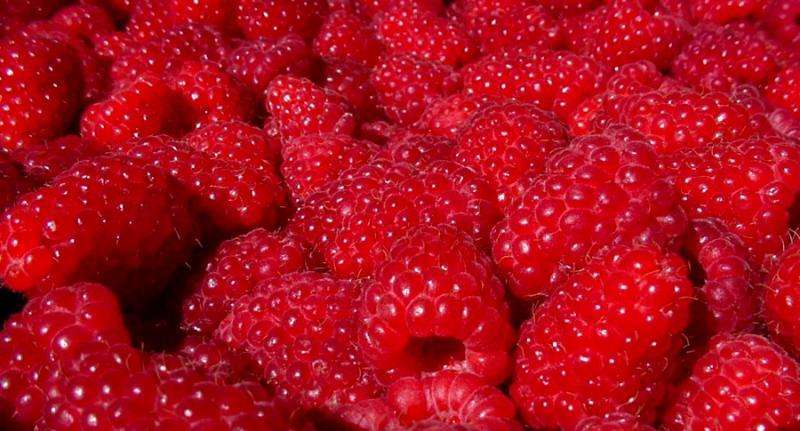Six new studies point to red raspberry's potential anti-inflammatory properties

A flurry of new research on red raspberries is set to be presented this week at the 2016 Experimental Biology conference in San Diego. Initial findings from six animal model studies reveal the potential effects of red raspberry consumption on cardiovascular disease risk reduction, maintaining normal blood glucose levels and liver function as well as potential anti-inflammatory effects related to bone health.
Recently, the January issue of Advances in Nutrition published a comprehensive review of the available scientific literature on the potential role of red raspberries in helping to reduce the risk of metabolically-based chronic diseases, including cardiovascular disease, diabetes mellitus, obesity, and Alzheimer's disease: all of which share critical metabolic, oxidative and inflammatory links.
"The new research being presented at Experimental Biology contributes to the growing body of nutrition research around the potential role of red raspberries in helping to reduce the risk factors associated with metabolically-based chronic diseases," said Tom Krugman, Executive Director of the National Processed Raspberry Council. "While further research in humans is needed, these animal studies provide important insights that will drive future research."
Red raspberries contribute a number of valuable essential nutrients, including providing an excellent source of vitamin C and nine grams of fiber per cup. They are also among the few plant foods that provide a source of ellagitannins and anthocyanins in the same package. While in vitro and animal studies suggests that these phytochemicals may help to reduce risk for some chronic diseases, additional research is needed to test similar hypotheses and possible effects in human metabolism.
Animal and in vitro (cell) research on red raspberries includes:
Cardiovascular
Dr. Ara Kirakosyan of the University of Michigan investigated the potential effects of red raspberry intake on obesity-prone rats.
Metabolic Syndrome
Dr. Neil Shay and colleagues from the Food Science and Technology department of Oregon State University, studied the effects of red raspberries in mice fed a high-fat, high-sugar Western diet.
Dr. Mei-Jun Zhu and colleagues at Washington State University looked at the potential effect of red raspberry consumption on metabolic syndrome in male mice with diet-induced obesity.
Diabetes
Principal investigator Dr. Giuliana Noratto of the Department of Food and Nutrition Science at Texas A&M University studied the effects of red raspberry consumption on diabetes-related complications and heart disease in obese diabetic mice.
Liver Function
Dr. Geoff Sasaki and colleagues at Oregon State University looked at the capacity for ellagic acid quercetin to bind to the peroxisome proliferator-activated receptor-alpha (PPARa).
Inflammation and Bone Health
Dr. Amber Thomas, of the Department of Nutrition and Food Sciences at Texas Woman's University and colleagues, using mouse macrophage cells, studied the anti-inflammatory effect of polyphenols in red raspberries in the production of osteoclasts, the cells associated with the breakdown of bone.
More information: Kirakosvan, A., et al. Cardioprotective Effects of Red Raspberries in Obesity-prone Rats. The FASEB Journal, April 2016, vol. 30, no. 1 www.fasebj.org/content/30/1_Su … 0d-b7eb-5fb5c01859bc
Shay, N.F., et al. Intake of Whole Raspberries and the Raspberry Phytochemicals, Ellagic Acid and Raspberry Ketone Reduces Adiposity, Improves Glucose Control and Changes Hepatic Gene Expression Profiles in High-fat Fed Mice. The FASEB Journal, April 2016, vol. 30 no. 1 www.fasebj.org/content/30/1_Su … 77-85ea-4460e9bd50f8
Zhu, M.J., et al. Dietary raspberries ameliorate metabolic syndromes in diet-induced obese mice. The FASEB Journal, April 2016 vol. 30 no. 1 www.fasebj.org/content/30/1_Su … 14-834d-37561f9fc59a
Noratto, G., et al. Effects of Raspberry Dietary Supplementation on Risk Biomarkers of Diabetes Related Complications and Heart Disease in Diabetic Mice The FASEB Journal, April 2016, vol. 30 no. 1 www.fasebj.org/content/30/1_Su … a8-be88-27f1650deea9
Sasaki, G., et al., Ellagic Acid and Quercetin are High-Affinity Ligands of Human Peroxisome Proliferator-Activated Receptor Alpha in an In-Vitro Competitive Binding Assay. The FASEB Journal, April 2016, vol. 30 no. 1 www.fasebj.org/content/30/1_Su … 3b-b867-f283a5d74756
Thomas, A., et al. Inhibitory Effects of Red Raspberry Polyphenols on Osteoclastogenesis in RANKL-Stimulated RAW264.7 Murine Macrophages. The FASEB Journal, April 2016, vol. 30 no. 1 www.fasebj.org/content/30/1_Su … f6-a0b1-2fb79c8fa210
















